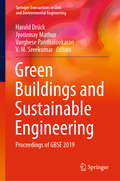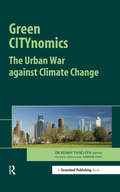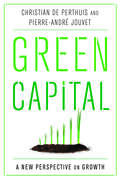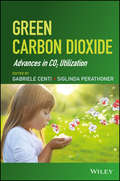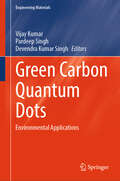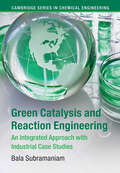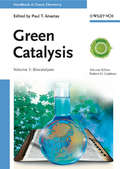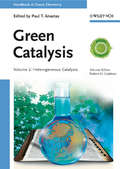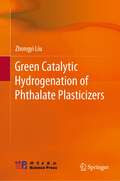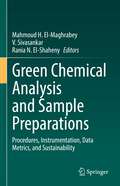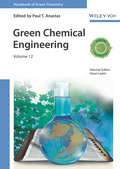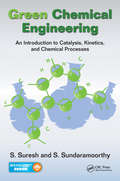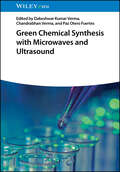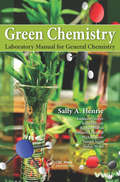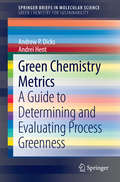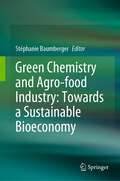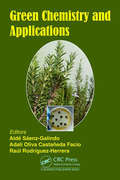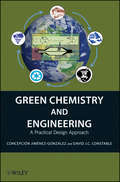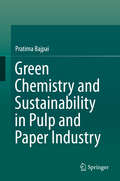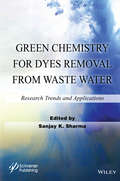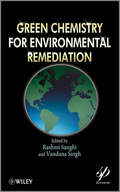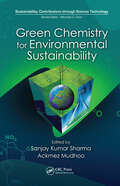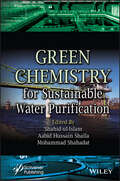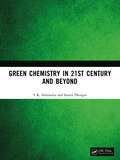- Table View
- List View
Green Buildings and Sustainable Engineering: Proceedings of GBSE 2019 (Springer Transactions in Civil and Environmental Engineering)
by Jyotirmay Mathur Harald Drück Varghese Panthalookaran V. M. SreekumarThis book comprises the proceedings of the International Conference on Green Buildings and Sustainable Engineering (GBSE 2019), which focused on the theme “Ecotechnological and Digital Solutions for Smart Cities”. The papers included address all aspects of green buildings and sustainability practices in civil engineering, and focus on ways and means of reducing pollution and degradation of the environment through efficient usage of energy and water. The book will prove a valuable reference resource for researchers, practitioners, and policy makers.
Green CITYnomics: The Urban War against Climate Change
by Kenny Tang Lorraine TangToday, more than half of the world's population are living in cities that are now contributing 80% of global greenhouse gas emissions. They cover less than 3% of the earth's surface. And urbanization continues apace. With such a massive carbon footprint, it is vital that cities are part of the solution. Despite this, scarcely any consideration has been given to the potential impact of climate change on urban dwellers, especially in the developing countries and burgeoning megacities of Africa, Asia and Latin America, where a wide variety of environmental and development challenges are likely to further exacerbate their vulnerability to climatic effects. Green CITYnomics presents a rich set of contributions by a highly diverse group of 45 of the world's leading urban experts on climate change. In particular, it illustrates the desire some cities are already demonstrating in engaging in this war. Standing still is not an option. Budgets have to be fought for; minds have to be won over; old, untenable and unsustainable ideas and solutions must be challenged; green and sustainable solutions must be given the chance to develop and to prove themselves. Each of the cities and urban centres discussed – from Hong Kong to Dresden; from Mexico City to Qatar – are, in their own ways, heroes and examples to us all. This book provides a compelling manifesto for the world's cities in their "Urban War against Climate Change". It is essential reading for climate scientists, national and local policy-makers and scholars worldwide.
Green Capital: A New Perspective on Growth
by Pierre-André Jouvet Christian de PerthuisMany believe economic growth is incompatible with ecological preservation. Green Capital challenges this argument by shifting our focus away from the scarcity of raw materials and toward the deterioration of the great natural regulatory functions (such as the climate system, the water cycle, and biodiversity). Although we can find substitutes for scarce natural resources, we cannot replace a natural regulatory system, which is incredibly complex. It is therefore critical that we introduce a new price into the economy that measures the costs of damage to these regulatory functions. This change in perspective justifies such innovations as the carbon tax, which addresses not the scarcity of carbon but the inability of the atmosphere to absorb large amounts of carbon without upsetting the climate system. Brokering a sustainable peace between ecology and the economy, Green Capital describes a range of valuation schemes and their contribution to the goals of green capitalism, proposing a new approach to natural resources that benefits both businesses and the environment.
Green Carbon Dioxide
by Siglinda Perathoner Gabriele CentiPROMISING NEW APPROACHES TO RECYCLE CARBON DIOXIDE AND REDUCE EMISSIONSWith this book as their guide, readers will learn a variety of new approaches and methods to recycle and reuse carbon dioxide (CO2) in order to produce green fuels and chemicals and, at the same time, minimize CO2 emissions. The authors demonstrate how to convert CO2 into a broad range of essential products by using alternative green energy sources, such as solar, wind, and hydro-power as well as sustainable energy sources. Readers will discover that CO2 can be a driving force for the sustainable future of both the chemical industry and the energy and fuels industry.Green Carbon Dioxide features a team of expert authors, offering perspectives on the latest breakthroughs in CO2 recycling from Asia, Europe, and North America. The book begins with an introduction to the production of CO2-based fuels and chemicals. Next, it covers such topics as:Transformation of CO2 to useable products through free-radical-induced reactionsHydrogenation of CO2 to liquid fuelsDirect synthesis of organic carbonates from CO2 and alcohols using heterogeneous oxide catalystsElectrocatalytic reduction of CO2 in methanol mediumFuel production from photocatalytic reduction of CO2 with water using TiO2-based nanocompositesUse of CO2 in enhanced oil recovery and carbon capture and sequestration More than 1,000 references enable readers to explore individual topics in greater depth.Green Carbon Dioxide offers engineers, chemists, and managers in the chemical and energy and fuel industries a remarkable new perspective, demonstrating how CO2 can play a significant role in the development of a sustainable Earth.
Green Carbon Quantum Dots: Environmental Applications (Engineering Materials)
by Vijay Kumar Pardeep Singh Devendra Kumar SinghThis book highlights the environmental applications of plant-mediated carbon quantum dots, i.e., detection of heavy metals, sensing of toxic organic compounds, degradation of dyes and other toxic compounds, antioxidant activity, antimicrobial activity, detection of drugs, etc. This book presents the chemistry and mechanism behind the synthesis and various environmental applications of QDs. This book is beneficial for researchers, professionals and students working in the fields of environmental sciences, material engineering, electronics, chemical engineering, biochemical and biomedical engineering, etc. It will be also useful in specialized courses in nanotechnology, green synthesis, Environmental Science & Engineering.
Green Catalysis and Reaction Engineering: An Integrated Approach with Industrial Case Studies (Cambridge Series in Chemical Engineering)
by Bala SubramaniamDiscover tools to perform Life Cycle Analysis (LCA) and develop sustainable chemical technologies in this valuable guide for chemists, engineers and practitioners. Tackling one of the key challenges of modern industrial chemical engineering, this book introduces tools to assess the environmental footprint and economics of key chemical processes that make the ingredients of everyday products such as plastics, synthetic fibers, detergents and fuels. Describing diverse industrial processes in detail, it provides process flow diagrams including raw material sourcing, catalytic reactors, separation units, process equipment and recycle streams. The book clearly explains elements of LCA and how various software tools, available in the public domain and commercially, can be used to perform LCA. Supported by real-world practical examples and case studies provided by industrial and academic chemists and chemical engineers, this is an essential tool for readers involved in implementing LCA, and developing next-generation sustainable chemical technologies.
Green Catalysis: Biocatalysis (Vol. 3)
by Paul T. Anastas Robert H. CrabtreeThe shift towards being as environmentally-friendly as possible has resulted in the need for this important volume on the topic of biocatalysis. Edited by the father and pioneer of Green Chemistry, Professor Paul Anastas, and by the renowned chemist, Professor Robert Crabtree, this volume covers many different aspects, from industrial applications to the latest research straight from the laboratory. It explains the fundamentals and makes use of everyday examples to elucidate this vitally important field. An essential collection for anyone wishing to gain an understanding of the world of green chemistry, as well as for chemists, environmental agencies and chemical engineers. The Handbook of Green Chemistry comprises of 9 volumes in total, split into 3 subject-specific sets. The three sets are available individually. All 9 volumes are available individually, too. Set I: Green Catalysis - Volume 1: Homogeneous Catalysis - Volume 2: Heterogeneous Catalysis - Volume 3: Biocatalysis Set II: Green Solvents - Volume 4: Supercritical Solvents - Volume 5: Reactions in Water - Volume 6: Ionic Liquids Set III: Green Processes - Volume 7: Green Synthesis - Volume 8: Green Nanoscience - Volume 9: Designing Safer Chemicals The Handbook of Green Chemistry is also available as Online Edition. Podcasts Listen to two podcasts in which Professor Paul Anastas and Journals Editor Paul Trevorrow discuss the origin and expansion of Green Chemistry and give an overview of The Handbook of Green Chemistry.
Green Catalysis: Heterogeneous Catalysis (Vol. 2)
by Paul T. Anastas Robert H. CrabtreeThe shift towards being as environmentally-friendly as possible has resulted in the need for this important volume on heterogeneous catalysis. Edited by the father and pioneer of Green Chemistry, Professor Paul Anastas, and by the renowned chemist, Professor Robert Crabtree, this volume covers many different aspects, from industrial applications to the latest research straight from the laboratory. It explains the fundamentals and makes use of everyday examples to elucidate this vitally important field. An essential collection for anyone wishing to gain an understanding of the world of green chemistry, as well as for chemists, environmental agencies and chemical engineers. The Handbook of Green Chemistry comprises of 9 volumes in total, split into 3 subject-specific sets. The three sets are available individually. All 9 volumes are available individually, too. Set I: Green Catalysis - Volume 1: Homogeneous Catalysis - Volume 2: Heterogeneous Catalysis - Volume 3: Biocatalysis Set II: Green Solvents - Volume 4: Supercritical Solvents - Volume 5: Reactions in Water - Volume 6: Ionic Liquids Set III: Green Processes - Volume 7: Green Synthesis - Volume 8: Green Nanoscience - Volume 9: Designing Safer Chemicals The Handbook of Green Chemistry is also available as Online Edition. Podcasts Listen to two podcasts in which Professor Paul Anastas and Journals Editor Paul Trevorrow discuss the origin and expansion of Green Chemistry and give an overview of The Handbook of Green Chemistry.
Green Catalytic Hydrogenation of Phthalate Plasticizers
by Zhongyi LiuThis book provides an overview of plasticizers, from the latest global research developments to the laws and regulations applied to their use. In addition the book details the author's recently developed methodology for a catalytic hydrogenation of phthalate plasticizers. It presents insights into the development of the catalytic phthalate hydrogenation from the reaction mechanism and catalyst characterization to pilot tests and its industrialization. Given its scope, the book will appeal to a broad readership, particularly professionals at universities and scientific research institutes, as well as practitioners in industry.
Green Chemical Analysis and Sample Preparations: Procedures, Instrumentation, Data Metrics, and Sustainability
by V. Sivasankar Mahmoud H. El-Maghrabey Rania N. El-ShahenyThis volume focuses on the most recent trends for greening analytical activities beginning with an introduction to green analytical chemistry followed by a discussion of green analytical chemistry metrics and life-cycle assessment approach to analytical method development. The chapters discuss two main topics; first is the most recent techniques for greening sample pretreatment steps, and second is modern trends for tailoring analytical techniques and instrumentation to implement the green analytical chemistry concept. The role of different kinds of green solvents, such as ionic liquids, supercritical fluids, deep eutectic solvents, bio-based solvents, and surfactants, as well as nanomaterials and green sorption materials in greening sample extraction steps is also a focus of this book. Furthermore, different approaches for greening chromatography as a key analytical technique are discussed. The applications of nanomaterials in analytical procedures are deeply reviewed, and miniaturization of spectrometers is also discussed as a recently evolved approach for efficient green on-site analysis. This book will appeal to a wide readership of academic and industrial researchers in different fields. It can be used in the classroom for undergraduate and postgraduate students focusing on the development of new analytical procedures for organic and inorganic compounds determination in different kinds of samples characterized by complex matrices composition. The book will also be useful for researchers that are interested in both chemical analysis and environment protection.
Green Chemical Engineering (Handbook of Green Chemistry)
by Paul T. Anastas Alexei LapkinGreen chemistry and chemical engineering belong together and this twelth volume in the successful Handbook of Green Chemistry series represents the perfect one-stop reference on the topic. Written by an international team of specialists with each section edited by international leading experts, this book provides first-hand insights into the field, covering chemical engineering process design, innovations in unit operations and manufacturing, biorefining and much more besides. An indispensable source for every chemical engineer in industry and academia.
Green Chemical Engineering: An Introduction to Catalysis, Kinetics, and Chemical Processes
by S. Suresh S. SundaramoorthyWhile chemical products are useful in their own right-they address the demands and needs of the masses-they also drain our natural resources and generate unwanted pollution. Green Chemical Engineering: An Introduction to Catalysis, Kinetics, and Chemical Processes encourages minimized use of non-renewable natural resources and fosters maximized pol
Green Chemical Synthesis with Microwaves and Ultrasound
by Chandrabhan Verma Dakeshwar Kumar Verma Paz Otero FuertesGreen Chemical Synthesis with Microwaves and Ultrasound A guide to the efficient and sustainable synthesis of organic compounds Chemical processes and the synthesis of compounds are essential aspects of numerous industries, and particularly central to the creation of drug-like structures. Their often significant environmental biproducts, however, have driven substantial innovations in the areas of green and organic synthesis, which have the potential to drive efficient, solvent-free synthesis and create more sustainable chemical processes. The use of microwaves and ultrasounds in chemical synthesis has proven an especially fruitful area of research, with the potential to produce a more sustainable industrial future. Green Chemical Synthesis with Microwaves and Ultrasound provides a comprehensive overview of recent advances in microwave- and ultrasound-driven synthesis and their cutting-edge applications. Green Chemical Synthesis with Microwaves and Ultrasound readers will also find: Introduction to the key equipment and tools of green chemical synthesis Detailed discussion of methods including ultrasound irradiation, metal-catalyzed reactions, enzymatic reactions, and many more An authorial team with immense experience in environmentally friendly organic chemical production Green Chemical Synthesis with Microwaves and Ultrasound is ideal for chemists, organic chemists, chemical engineers, biochemists, and any researchers or industry professionals working on the synthesis of chemicals and/or organic compounds.
Green Chemistry Laboratory Manual for General Chemistry
by Sally A. HenrieGreen chemistry involves designing novel ways to create and synthesize products and implement processes that will eliminate or greatly reduce negative environmental impacts. Providing educational laboratory materials that challenge students with the customary topics found in a general chemistry laboratory manual, this lab manual enables students to see how green chemistry principles can be applied to real-world issues. Following a consistent format, each lab experiment includes objectives, prelab questions, and detailed step-by-step procedures for performing the experiments. Additional questions encourage further research about how green chemistry principles compare with traditional, more hazardous experimental methods.
Green Chemistry Metrics
by Andrew P. Dicks Andrei HentThis contribution to SpringerBriefs in Green Chemistry outlines and discusses the four major green chemistry metrics (atom economy, reaction mass efficiency, E factor and process mass intensity), at a level that is comprehensible by upper-level undergraduates. Such students have previously received fundamental training in organic chemistry basics, and are ideally positioned to learn about green chemistry principles, of which metrics is one foundational pillar. Following this, other green metrics in common use are discussed, along with applications that allow important calculations to be easily undertaken. Finally, an introduction to metrics in the context of life cycle analyses is presented. It should be noted that no other available publication teaches green chemistry metrics in detail with an emphasis on educating undergraduates, whilst simultaneously providing a contemporary industrial flavour to the material.
Green Chemistry and Agro-food Industry: Towards a Sustainable Bioeconomy
by Stéphanie BaumbergerThe objective of the book is to show the complementarity and integration of food and non-food value chains for the development of a sustainable bioeconomy. One current challenge facing industry and the economy is to meet the needs of a growing world population while preserving the environment. The use of fossil energy resources for several decades has generated a decrease in reserves of these resources, together with a phenomenon of global warming due to the release of greenhouse gases into the atmosphere. More and more industrial sectors, including the chemical industry, are replacing fossil carbon with renewable carbon. The bioeconomy consists in using renewable biological resources to produce food, materials, and energy. A bioeconomy based on the green chemistry and biotechnologies is developing worldwide, as a lever for reducing the ecological footprint of human activities. The book is articulated around six parts, each dedicated to a keystone of the interface betweengreen chemistry and Agro-Food Industry.
Green Chemistry and Applications
by Aidé Sáenz-Galindo; Adali Oliva Castañeda-Facio; Raúl Rodríguez-HerreraGreen chemistry is a work tool that can be applied in different areas such as medicine, materials, polymers, food, organic chemistry, etc., since it was propounded in the early 2000s. It has become a viable alternative for care, remediation and protection of the environment and has been implemented worldwide. In this book the twelve principles of green chemistry are presented in a simple way, with examples of the applications of green chemistry in numerous areas showcasing it as an ideal alternative for environmental care. It also provides information on current research being implemented at the pilot plant and industrial level. The book demonstrates the importance of the use of renewable raw materials, the use of catalysis and the implementation of alternative energy sources such as the use of microwaves and ultrasound in different separation and chemical processes.
Green Chemistry and Engineering
by Anne E. Marteel-Parrish Martin A. AbrahamAlthough many were skeptical of the green chemistry movement at first, it has become a multimillion-dollar business. In preventing the creation of hazardous wastes, laboratories and corporations can save millions in clean up efforts and related health costs. This book supplies students with concepts commonly taught in undergraduate general chemistry and general engineering courses, but with a green perspective. It is unique in presenting an integrated discussion of green chemistry and engineering from first principles - not as an afterthought. Real-world examples show creative problem solving based on the latest issues.
Green Chemistry and Engineering
by Concepción Jiménez-González David J.C. ConstableThe past, present, and future of green chemistry and green engineeringFrom college campuses to corporations, the past decade witnessed a rapidly growing interest in understanding sustainable chemistry and engineering. Green Chemistry and Engineering: A Practical Design Approach integrates the two disciplines into a single study tool for students and a practical guide for working chemists and engineers.In Green Chemistry and Engineering, the authors--each highly experienced in implementing green chemistry and engineering programs in industrial settings--provide the bottom-line thinking required to not only bring sustainable chemistry and engineering closer together, but to also move business towards more sustainable practices and products. Detailing an integrated, systems-oriented approach that bridges both chemical syntheses and manufacturing processes, this invaluable reference covers:Green chemistry and green engineering in the movement towards sustainabilityDesigning greener, safer chemical synthesisDesigning greener, safer chemical manufacturing processesLooking beyond current processes to a lifecycle thinking perspectiveTrends in chemical processing that may lead to more sustainable practicesThe authors also provide real-world examples and exercises to promote further thought and discussion.The EPA defines green chemistry as the design of chemical products and processes that reduce or eliminate the use or generation of hazardous substances. Green engineering is described as the design, commercialization, and use of products and processes that are feasible and economical while minimizing both the generation of pollution at the source and the risk to human health and the environment. While there is no shortage of books on either discipline, Green Chemistry and Engineering is the first to truly integrate the two.
Green Chemistry and Sustainability in Pulp and Paper Industry
by Pratima BajpaiThis book features in-depth and thorough coverage of Minimum Impact Mill Technologies which can meet the environmental challenges of the pulp and paper industry and also discusses Mills and Fiberlines that encompass "State-of-the-Art" technology and management practices. The minimum impact mill does not mean "zero effluent", nor is it exclusive to one bleaching concept. It is a much bigger concept which means that significant progress must be made in the following areas: Water Management, Internal Chemical Management, Energy Management, Control and Discharge of Non-Process Elements and Removal of Hazardous Pollutants. At the moment, there is no bleached kraft pulp mill operating with zero effluent. With the rise in environmental awareness due to the lobbying by environmental organizations and with increased government regulation there is now a trend towards sustainability in the pulp and paper industry. Sustainable pulp and paper manufacturing requires a holistic view of the manufacturing process. During the last decade, there have been revolutionary technical developments in pulping, bleaching and chemical recovery technology. These developments have made it possible to further reduce loads in effluents and airborne emissions. Thus, there has been a strong progress towards minimum impact mills in the pulp and paper industry. The minimum-impact mill is a holistic manufacturing concept that encompasses environmental management systems, compliance with environmental laws and regulations and manufacturing technologies.
Green Chemistry for Dyes Removal from Waste Water
by Sanjay K. SharmaThe use of synthetic chemical dyes in various industrial processes, including paper and pulp manufacturing, plastics, dyeing of cloth, leather treatment and printing, has increased considerably over the last few years, resulting in the release of dye-containing industrial effluents into the soil and aquatic ecosystems. The textile industry generates high-polluting wastewaters and their treatment is a very serious problem due to high total dissolved solids (TDS), presence of toxic heavy metals, and the non-biodegradable nature of the dyestuffs in the effluent. The chapters in this book provide an overview of the problem and its solution from different angles. These problems and solutions are presented in a genuinely holistic way by world-renowned researchers. Discussed are various promising techniques to remove dyes, including the use of nanotechnology, ultrasound, microwave, catalysts, biosorption, enzymatic treatments, advanced oxidation processes, etc., all of which are "green." Green Chemistry for Dyes Removal from Wastewater comprehensively discusses: Different types of dyes, their working and methodologies and various physical, chemical and biological treatment methods employed Application of advanced oxidation processes (AOPs) in dye removal whereby highly reactive hydroxyl radicals are generated chemically, photochemically and/or by radiolytic/ sonolytic means. The potential of ultrasound as an AOP is discussed as well. Nanotechnology in the treatment of dye removal types of adsorbents for removal of toxic pollutants from aquatic systems Photocatalytic oxidation process for dye degradation under both UV and visible light, application of solar light and solar photoreactor in dye degradation
Green Chemistry for Environmental Remediation
by Vandana Singh Rashmi SanghiThe book presents an in depth review from eminent industry practitioners and researchers of the emerging green face of multidimensional environmental chemistry. Topics such as green chemistry in industry, green energy: solar photons to fuels, green nanotechnology and sustainability, and green chemistry modeling address a wide array of iusses encouraging the use of economical ecofriendly benign technologies, which not only improve the yield, but also illustrates the concept of zero waste, a subject of interest to both chemists and environmentalists alike.
Green Chemistry for Environmental Sustainability (Sustainability: Contributions through Science and Technology)
by Ackmez Mudhoo Sanjay KumarSharmaWhen the Nobel Prize Committee recognized the importance of green chemistry with its 2005 Nobel Prize for Chemistry, this relatively new science came into its own. Although no concerted agreement has been reached yet about the exact content and limits of this interdisciplinary discipline, there seems to be increasing interest in environmental topic
Green Chemistry for Sustainable Water Purification
by Mohammad Shahadat Shahid-Ul-Islam Abid Hussain ShallaGREEN CHEMISTRY for Sustainable Water Purification Green Chemistry for Sustainable Water Purification provides systematic coverage of the most recent research and development in clean water treatment technologies based on green materials and nanocomposites. Providing safe drinking water is one of the top priorities for scientists and industrialists working on projects, and one particular problem is the contamination of groundwater with toxic organic and inorganic compounds released by various industries. The presence of contaminants or industrial effluents in drinking water systems has increasingly become a major environmental challenge. To address the problem, several methods, including ion exchange, membrane filtration, advanced oxidation, biological degradation, photocatalytic degradation, electro-coagulation, and adsorption, are in operation for removing or minimizing these wastes. The purification process of wastewater using conventional methods, however, has proved to be markedly ineffective, very difficult, and highly expensive. On the other hand, for the remediation of water resources, a concept like green chemistry, based on the application of biological agents including polymers, bacteria, and fungi, has received great scientific attention as it helps to avoid the toxic by-products of conventional techniques and enhances eco-friendly wastewater treatment approaches. This book discusses the different treatment technologies with a special focus on the green adsorption approach, using biological and hybrid biochemical treatment technologies to prevent water contamination and maintain the ecosystem. It discusses the analysis of organic and inorganic pollutants from industrial wastewater. It also focuses on the removal and recovery of organic and inorganic contaminants from the environment and several case studies describing the removal and recovery of environmental pollutants using green technology are given. The recycling of low-cost along with green adsorbent technology is explained in detail. Finally, the book highlights treatment technologies with effective pollutant removal capacities that are used in modern water treatment units. Audience The book will serve as an important resource for materials scientists, chemists, chemical engineers, biotechnologists, textile engineers and environmental scientists. It will also be valuable to industrial organizations, consulting engineering companies, etc. for the selection and implementation of the most sustainable wastewater treatment technologies.
Green Chemistry in 21st Century and Beyond
by V.K. Ahluwalia Sunita DhingraWith an emphasis on minimizing the use and generation of hazardous substances, Green Chemistry is a significant branch of Chemical Engineering. This book details the fundamentals associated with this field of study and focuses on designing products through renewable starting materials, recyclable chemicals, and benign synthesis. The use of green solvents, organic transformations, catalysts, and electrochemical synthesis are also discussed.The subject matter of this book also includes: Twelve Principles of Green Chemistry Baylis-Hillman Reaction Perfluorinated Catalysts Microwave assisted Organic Transformations in Water Reformatsky Reaction This book is aimed at Engineering students, chemists working in the R&D sector, and undergraduate and postgraduate scholars.Print edition not for sale in South Asia (India, Sri Lanka, Nepal, Bangladesh, Pakistan or Bhutan)
